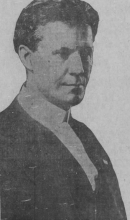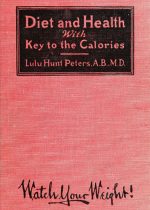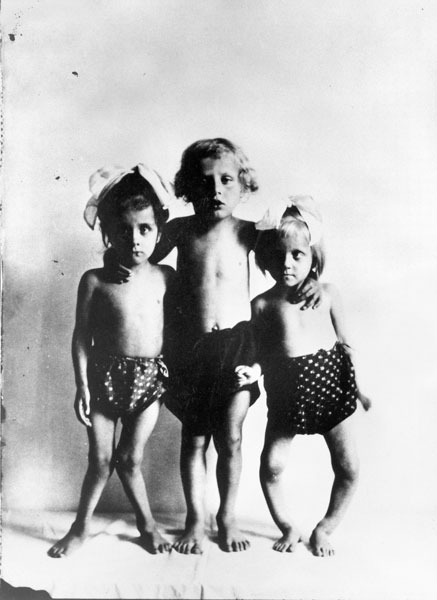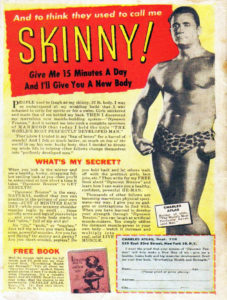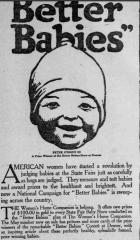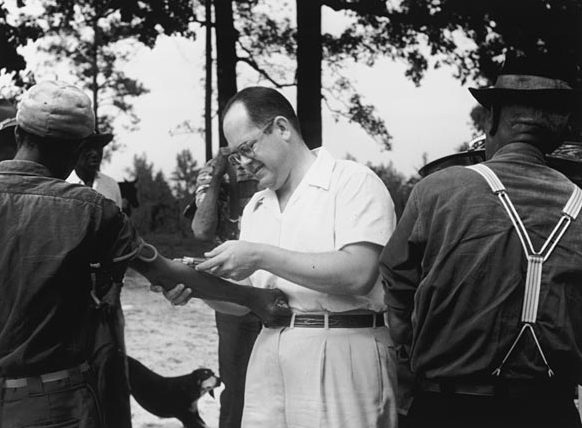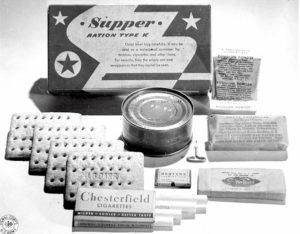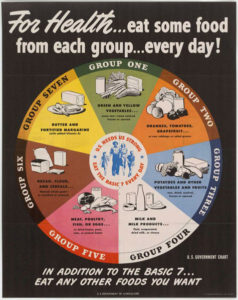1902 The mechanical revolution created a mark on farming practices. Irrigation became popular thanks to the Reclamation Act, and staple crops allowed farmers to increase their production because they were able to farm more ground with machinery.
1902 The Journal of the American Medical Association (JAMA) endorsed the practice of denying women who were suffering complications from an abortion medical care until they admitted who was involved in the procedure. This practice prevented many women from seeking needed medical assistance and led to their deaths.
1904 21.3% of incarcerated women were black, 15.3% of incarcerated men were black.
1905 The Kellogg Company was selling about 150 cases of cornflakes per day, not counting other products. One of their popular snacks was Graham Crackers, named after Sylvester Graham. Kellogg was a fan and a follower of Graham’s diet recommendations.
1906 Under President Roosevelt, the Pure Food and Drug Act passed for food safety and consumer protection. It was designed to guard against misleading advertisements, quackery, and unlabeled and unsafe ingredients in food and medicine.
1906 Frederick Hopkins proposed that vitamins exist and that not getting enough vitamins causes scurvy and rickets.
1906 John Harvey Kellogg, of the Kellogg Company, provided capital to help found the Race Betterment Foundation in Battle Creek, Michigan. This was a eugenics institution that promoted the idea that ‘inferior’ peoples should not be permitted to reproduce. Kellogg warned that if white women had one child with a black man, all her kids afterwards would be part black, and this would be bad blood.
1907 Kellogg was asked to step down from the Seventh Day Adventist church leadership. Ellen White, as well as several other church leaders, was an abolitionist who felt the church should spread its message to all people of all races, whereas Kellogg was concerned with furthering the Anglo-Saxon health for race preservation. The church also felt he was spending more time doing things aligned with his medical duties, like surgery, instead of preaching. He remained medical director of the Sanitarium.
1907 Eugenics laws began passing at the state level in the US and continued for over 70 years. Based on the deeply flawed idea that ‘inferior’ people should not be permitted to have children, these laws permitted barbaric practices, such as forcing unwanted sterilizations on women of color, the disabled, and the mentally ill, which were often performed either while the women were still in labor or under the guise of an appendectomy. 1/3 of procedures were done on girls aged 9-18. These procedures were performed without patient consent in 32 states.
“In the early 20th century across the country, medical superintendents, legislators, and social reformers affiliated with an emerging eugenics movement joined forces to put sterilization laws on the books. Such legislation was motivated by crude theories of human heredity that posited the wholesale inheritance of traits associated with a panoply of feared conditions such as criminality, feeblemindedness, and sexual deviance. Many sterilization advocates viewed reproductive surgery as a necessary public health intervention that would protect society from deleterious genes and the social and economic costs of managing ‘degenerate stock'” (Stern, 2005)
1908 15,000 women marched through New York to protest for shorter hours, better pay, and voting rights.
1908 February 28th was the first National Women’s Day in the US.
1908 New Jersey was the first state to treat drinking water with chlorine.
1908 Mutual Life Insurance Company of New York and New York Life Insurance Company had collected female weights and heights of 59,525 policy holders. Louis I Dublin, a statistician, compiled this data into a standard table of heights and weights for men and women. Overweight and underweight were considered 10-15% above or below the “average.” This author couldn’t locate what the average weight for females was as it was defined in the literature.
1909 The Actuarial Society of America and the Association of Life Insurance Medical Directors of America collaborated on an industry-wide study to assess mortality risk by population, disease, age, etc. using data from 1870 to 1909. The intention was to create a standardized method for assessing risk in people who fell into borderline categories of perceived risk of mortality. This research effort was called the Medico-Actuarial Investigation. Their research used information on 221,819 white males and 136,504 white female policyholders all between the ages of 15 and 55. People under age 25 who were underweight were at high health risk. Being moderately overweight was encouraged up until age 35 but not after 35. From this data, the average height from males was determined to be 5 ft 8 ½ inches and for females 5ft 4 ½ inches. The average weight for males was 155 lbs. No average weight for females was reported in the publication.
1910 Hollywood was born. It’s first movie premiered in 1910, and within five years it was a major motion picture hub.
1910 Charles Davenport (an associate of John Harvey Kellogg) and Harry Laughlin opened the Eugenics Record Office on Long Island. They collected family history data on physical, mental, and moral traits to determine what undesirable traits were.
1911 International Women’s Day was established and over one million people attended rallies for women’s right to work, vote, be trained, hold office, and to end discrimination.
1911 James Oppenheim’s poem Bread and Roses is published in American Magazine. The following year in 1912, women began the Bread and Roses campaign initiated by the Lawrence Textile Mill strike due to pay reduction. They advocated for better pay and working conditions.
1913 Mary Wilson was arrested and charged with murder after she shot a white police officer for sexually assaulting her.
1912 Faneuil S. Weisse, director of the Mutual Life Insurance Company of New York, created a table that included weights, as well as chest and abdominal measurements per inch of height from the data of 3035 men. This was done in response to criticisms that the existing standard height and weight tables were flawed due to subjective weight recordings, faulty scales, and human error in recording the data. Weiss used this data to create a mathematical formula to approximate weight. If the weight estimated by the medical examiner didn’t match with this new math equation, then the recorded weight was wrong and they would request an actual scale weight.
1912 Louis I. Dublin, a statistician at The Metropolitan Life Insurance Company (later known as MetLife) took data from 43 insurance companies to compile a new height and weight standardized table for his company. Twice as many white men than white women were included in this data collection. There is no indication that anyone other than white people were included in this data.
1912 Louis-Camille Maillard, a French chemist, published a paper describing the creation of food flavors and odors that occurs during a chemical reaction between sugar, high heat, and amino acids. The Maillard reaction, as it became known, offered an expansion of food language to describe the smells of popcorn, barbecued food, baked bread, and sauces.
1913 Food manufacturers joined forces and established the Research laboratory of the National Canners Association to study why food would become spoiled and how. They discovered that adding salt to canned foods reduced cooking time and food retained color better (green beans turned grey without it).
1913 Personal weight scales became available and were used in the home. Doctors were starting to ask patients what their exact weight was. Up until this point, weight wasn’t a thing. The size and shape of people, especially that of women, was a testament to their morality in the eye of the religious. To race scientists, they were visual representations of where one stood on the social and class hierarchy. Most doctors at this time didn’t discuss weight, thinness, or fatness in terms of health. But that would soon change.
1914 WWI began and lasted until 1918.
1915 Dr. Harry J Haiselden, a big supporter of eugenics, convinced the parents of an infant that the baby needed to die because he was born with syphilis. Haiselden was adamant that the boy would grow up to be a miserable outcast. The public was outraged, but Helen Keller wrote in support of the doctor’s decision. After the baby’s death, the coroner determined the child had brain damage but wasn’t syphilitic.
1917 The American Dietetic Association was founded by Lenna F. Cooper and Lulu C. Graves with intentions to aid the government in food conservation and improve public health and nutrition.
1917 Alan L. Hart became the first female to male transgender man to successfully have a hysterectomy and gonadectomy in the United States.
1917 Immigrants over age 16 were required to pass a literacy test.
1918 Fad Diet: Calorie Counting introduced by Lulu Hunt Peters’ book Diet and Health, with Key to the Calories. Peters revered thinness and called people who wanted to gain weight “deluded.” She said that people in larger bodies “are considered a joke” and are viewed with “distrust, suspicion, and even aversion.” Additionally, she claimed that “efficiency decreases in direct proportion as excess weight increases.” Of course, she provided no source or supporting evidence at all for this claim.
1918 Carrie Chapman Catt helped change President Wilson’s political stance on women’s right to vote when she tied the suffrage movement to women’s involvement in WWI.
1918 A Journal of the American Medical Association (JAMA) article titled, “Food and Obesity” reported that, although the anonymous author was also concerned with fat people, assuming fatness is due to overconsumption of food and lack of exercise needs to be proven, as many “corpulent” people reported not eating that much. The author suggested that if there was a way to find evidence that obese people were in truth “uneconomical” in their eating habits, then “there [was] an added force to the Food Administration’s advice to our corpulent citizens to burn their own fat and thereby save fuel for the nation’s fighters.”
1920 The first radio advertisement aired on KDKA.
1920 It’s estimated that 20 million immigrants moved to America between 1880-1920 fleeing persecution, famine, and poverty. They were desperate for a better life.
1920 The 19th Amendment was passed and ratified, stating that the right of citizens of the United states to vote shall not be denied or abridged by the United States or by any state on account of sex.
1920s Most US states and cities had water sanitation programs. Tuberculosis and other waterborne diseases were dramatically reduced because of it. It was no longer recommended that youth under the age of 35 be slightly overweight because risk of dying due to tuberculosis was not an issue any longer. Also, because the risk of death due to waterborne diseases had become scarce, the idea that people could manipulate their weight and shape to conform to cultural aesthetics became more popular. Cultural aesthetics were purported to be related to health and living a longer health.
1920s A lot happened during this decade, starting with Coco Chanel. She created a dress with a lower waistline, shorter hemline and more androgynous straight lined silhouette, and thus, the era of the Flapper dress was born. Because of the straight lines, women bound their breasts and restricted their eating to hide their natural shape and fit into these dresses. This was in direct rebellion against the Victorian era hourglass shapes, and, although it came about during the same era as the 19th Amendment, it birthed an unrealistic ideal that women should look like undeveloped teenagers.
1920s Women were fretting over how to manipulate their bodies into rectangles, and advertisers and companies saw them as easy targets. Marketers and advertisers had learned from magazines like Godey’s Lady’s Book, Cosmopolitan, and Harper’s Bazaar, as well as from newspapers over the past century, that fashion and nutrition advice directed towards women sold more ad space and more products. Using this information and the latest fashion trends, advertisers flooded the market with thin models dressed as flappers selling laxatives, deodorants, make up, scales, cigarettes, and even soaps that claimed to reduce your body size with each use. Women were repeatedly told that to be happy you must be thin. Men weren’t entirely left out of this movement; they were being told that muscles made the man. Muscles for men and thinness for women were the new keys to success.
1920s Indoor plumbing, heating, and electricity were becoming commonplace. Sports organizations were on the rise. Vaccines were being created for tuberculosis and several other awful diseases. No longer just about aesthetics and spirituality, dieting became a mainstream health issue and bodies were no longer just bodies, they were industrial machines that needed to be efficient, economical, and beautiful. ‘Reducing’ was the term used for weight loss, and the 1920s reducing movement was a craze like none other. It is the origin of contemporary consumer culture. Mike Featherstone, cultural sociologist, stated that, “consumer culture uses advertising to generate continual dissatisfaction and self consciousness, especially in the age of physical appearance, to get people to buy exercise courses, pills etc.”
1920s Movie stars’ lives began to get documented in magazines.
1921 Edward Mellanby discovered Vitamin D and that a deficiency of it caused rickets, which is a weakening of the bones that results in stunted growth, pain, and even skeletal deformities, such as bowed legs. Frederick Banting and Charles Best discovered insulin. Between 1921 and the 1940s, all major vitamins were discovered (A, B1, B12, C, D, E, K). The disease beriberi, which affects the heart and circulatory system, was discovered to be a result of a Vitamin B1 deficiency. Pellagra, which causes dermatitis, dementia, and diarrhea, was discovered to be due to deficiencies in B3. Scurvy, which results in anemia, weakness, bruising, and bleeding, was because of a lack of Vitamin C. Researchers discovered they could make synthetic versions of vitamins to supplement people who were deficient in them, making the diseases caused by vitamin deficiencies disappear.
1921 JAMA articles mentioning terms like obesity and overweight began increasing with medical concerns surrounding the ultra thin and obese. Even though both extremes posed increased mortality risk, centuries of religious and racial biases gave more attention and publication permissions to those articles addressing overweight and obesity links to health and mortality risks. According to Sabring Strings book, Fearing the Black Body, “Between 1883 and 1920, only 56 articles mentioning obesity and 3 mentioning overweight were published, for a combined total of 59 articles containing those terms. However, between 1921 and 1940, that total ballooned to some 214 articles. The term ‘fatness’ yielded totals of 359 articles before 1921, but shot to 530 between 1921 and 1940. By contrast, between 1883 and 1920, 247 articles were published using the term ‘thinness,’ and only two with the word ‘underweight.’ This was a combined total of 249 articles. Between 1921 and 1940, that total had dropped to a meager 156.”
1923 Rudyard Kipling, Boy Scouts Commissioner published Land and Sea Tales. He wrote the now famous children’s poem, “Eenee, Meenee, Mainee, Mo!” Only the tiger was, in fact, the racial slur ending in -er.
1924 The Immigration Act of 1924 set a nationality quota. 2% of each nationality was allowed into the US.
1924 Dr. Elliott Joslin, a noted medical author in JAMA, wrote, “The Jew, in my opinion, is not prone to diabetes because he is a Jew, but rather because he is fat. Jews are fat; though shameful to relate.” Joslin admits he has no data to support his views and it is his own racial views between Gentiles and Jews.
1925 Elmer McCollom and Nina Simmonds wrote an assessment of medical and cultural aesthetics on weight and stated, “What we call a normal weight is not an arbitrary established standard like fashion in dress, but is a weight which corresponds with a bodily symmetry with which we have long associated certain qualities which are universally admired… A certain amount of fat is essential to the appearance of health and beauty. It is an indication that the state of nutrition is good… We all agree that excessive fat makes one uncomfortable and unattractive.”
1925 Fad Diet: Cigarette Diet. The slogan was “Reach for a Lucky instead of a sweet.”
1927 The electronic television was invented by Philo Taylor Farnsworth at 21 years of age.
1927 Your Weight and How to Control It: A Scientific Guide by Medical Specialists and Dieticians by Morrish Fishbein, then editor of JAMA, was published. He wrote that the first Adult Weight Conference was held the previous February and it was decided that women under 30 needed to gain weight for child bearing and women after 30 needed to avoid being overweight.
1928 Alexander Fleming discovered penicillin.
1928 Fad Diet: Inuit Meat and Fat Diet, which consisted of caribou, raw fish, and whale blubber.
1929 The Reducing Craze was technically over; however, the legacy of body consciousness, consuming health, quick weight loss fixes, consumer culture, and popular media remain to this day.
1929-1933 The Great Depression: Between the stock market crashing in 1929, people taking all their money out of the banks for cash, the influx of gold coming into the US destabilizing the value of money, and a reduction in international lending and tariffs, the prices for goods plunged, and in response, farmers planted and plowed more land to make up for lost income. This required the removal of native, prairie grasses. Removal of these grasses, whose long root systems anchored the soil down, coupled with over plowing, created a horrific drought and the conditions for the Dust Bowl. There was a severe lack of food during a time of significant unemployment and uncertainty. People were starving to death, and underrepresented communities were deeply impacted. Immigration populations decreased from 14.2 million to 10.3 million. Though people were hungry, the indulgence in foods was viewed as shameful and insensitive to others. The dieting market skyrocketed, as people were desperate for ways to not be hungry and lower body size, so they weren’t seen as indulgent.
1930s- The Depression led to a spike in abortion rates. Women were able to get abortions at clinics, despite legal restrictions.
1930: Charles Atlas, born Angelo Siciliano, took out magazine and newspaper advertisements to market his body building secrets. His strategy was to promote his history of being bullied for being scrawny and losing his girlfriend over it, saying, “The insult that turned a chump into a champ.”
1930 Fad Diet: The Hay Diet. Foods were divided into alkaline, acid or neutral categories and acidic and alkaline foods couldn’t be combined because the body supposedly wasn’t able to digest them.
1930 Fad Diet: Dr. Stoll’s Diet Aid. This was the first liquid diet drink.
1930 Mrs. Marie Meloney, editor of The New York Herald Tribune and creator of a forum called Current Problems, reported getting 2000 inquiries per month on weight control, most of which were from women wanting advice on how to be a size 16, which by size standards at that time, may have been a size small.
1930 Charles P Clark, the director of the Mutual Benefit Life Insurance Company, pulled 10,000 cases at random to study heights, weights, and body circumferences. His goal was to create an updated “standard” of weight and height so that the company could determine the health status of possible policy holders. Anyone with health concerns, such as having had contact with a person with tuberculosis, excessive drinking, or any number of other medical issues, was automatically rejected. If health status was imperfect but only to a minor degree, they were offered a policy but at a higher rate.
1930 Dr. Willard Stone wrote in JAMA, “during pregnancy [women need to ensure] virility of the race [by what they eat, if] a race of supermen is ever to be obtained.” This quote is later described as medical sexism. Around this time, religious fervor had wound down, and medicalization of women’s bodies (biopolitics) filled the void, aided by eugenics research on birth control, mass marketing to women, and white supremacist medical views.
1931 Berlin, Germany. Dora Richter became first known transgender woman to have a successful vaginoplasty.
1932 US Public Health Service Syphilis Study at Tuskegee lasted from 1932 to 1972. Six rural communities were identified in Alabama, Tennessee, Mississippi, and Virginia as the research sites. They recruited black males who were suffering from syphilis to observe the progression of the disease. Only black males were recruited, and they were not fully informed of the experiments, nor were they able to give full consent. Treatment was denied to them even after penicillin was discovered as the cure.
1933 The Agricultural Adjustment Act of 1933 incentivized farmers to not over-produce by paying them subsidies to not farm on part of their land. It also bought livestock for slaughter as farmers struggled to feed them. In order to pay for the subsidies, the government taxed companies that processed farm products. This act created a new government agency, The Agricultural Adjustment Administration, which later became the US Department of Agriculture. This was the government’s first large-scale effort to address public economic welfare in the US. Reducing the use of farm land, slaughtering animals that weren’t going to be eaten, and burning corn as cheap fuel didn’t make a lot of sense to people, given the incredible rates of starvation at the time. The Act mostly benefited large farmers and food processors and didn’t really support small farmers and the sharecroppers in the south, who were mostly African Americans.
1934 Fad Diet: The Banana and Skim Milk Diet, which was supported by the United Fruit Company.
1935 GNC, the supplement company, was created this year.
1936 The first health club in Oakland, CA was established. The owner, Jack LaLanne, created leg extension machines, and doctors told him it would give people heart attacks. His company became Bally Total Fitness.
1937 Thanks to the eugenics movement, Law 116 was passed in Puerto Rico, allowing institutionalized population control. It’s estimated that between 1937 and 1976, 37% of women of childbearing age were sterilized. One of the major eugenics movement leaders was Clarence Gamble, heir of the Procter & Gamble corporation. He was the president and founding member of several birth control associations. He claimed that reducing the birthrate of African Americans was the solution to poverty. He and his colleagues manipulated many women into sterilization, telling them that the procedure was temporary, and that if they refused, they would be denied healthcare in the future.
1937 By this point, most research surrounding mortality from various diseases by age, gender, weight, and height used the data from the Medico-Actuarial Investigation in some way. Research had generally found that as people aged, their weight increased a little each year until after age 60, when it often started to decline, and there was an increase in diagnosis of almost all medical illnesses, such as heart disease, hypertension, cancer, and diabetes. Additionally, they found the lowest mortality rates were among those who were slightly under the average weight listed in the actuarial table. At this point, the medical community was not in a position to conduct large scale data collection and leaned on the life insurance data as an easy reference tool. In the years between the investigation study and now, several physicians employed by insurance companies published articles in medical journals on the data. When it came to weight and health, it was reported that people who fell well outside the averages were at greatest risk of mortality. This included people who were considered “obese.” Insurers refused to provide coverage for people at high mortality risk and doctors saw this as a way to determine whom they wanted to take on as a patient.
1937 Insurance companies initiated public health campaigns with the intention of extending longevity of their policyholders. They established welfare divisions that created educational booklets and movies, and they worked with state health departments to increase funding for public health programs, and disease prevention and treatment. Women, at this point, comprised a growing number of policyholders, were members of the workforce, and had greater influence on domestic affairs. Because of these reasons and previous racial and gender biases, welfare campaigns began targeting women more directly and frequently.
1939 The Metropolitan Life Insurance company noticed a trend of weight decline by a few pounds, which they attributed to the popularization of thin actresses in movies and the media. They claimed it was a good trend and aided the future health of the population.
1939-1945 WWII. The military began developing processed foods that could be shipped overseas to feed soldiers. Spam, dehydrated potatoes, and powdered juice, among others, were created. Foods that couldn’t be easily shipped overseas, like dairy and eggs, became the staple of American diets and increased the need for home refrigeration, which in turn increased sales of home refrigerator units and other home appliances. Many women went to work during this time. More middle class women were now in charge of home and food preparation, as well as having to work.
1940s and 1950s- Across the country, abortion clinics were shut down by the police. Abortion became increasingly difficult to access, and there was an increase in dangerous, self-abortions.
1941 Physiologist Ancel Keys was hired by the US Department of War to study food deprivation in men. His work produced a food ration called Survival K Ration that soldiers were given during wartime. His interest in nutrition was sparked, and Keys continued his studies by recruiting civilians to partake in experiments surrounding underfeeding and how to bring men back from near starvation.
1942 War rationing added fuel to the national idea of fatness as a problem. Now, it was not just about health, but also about the economy. The social dialogue about fatness surrounded its impact on risk of disease and mortality, general health, and the economic well being of the nation as a whole. It was no longer just those who fell in the category of extreme obesity who were treated with disdain, it was also those who appeared even slightly corpulent.
1942 Louis Dublin, of the Metropolitan Life Insurance Company, created ideal weights for women and men 25 years of age and older. These weights were based on frame size- small, medium, or large. There was no indication of how to determine which frame size a person had because, in the development of these ideals, there was no such measurement taken. These ideal weights were designed to create new guidelines about which applicants were considered favorable or not. The new ideal weights omitted data on weight increasing as people aged, which had been observed in every other report of this kind to date. Since 1911, this insurance company had observed an increase in life expectancy of 17 years and a decrease in death rates. Up to this point, young, underweight people were denied coverage for fear that they would get tuberculosis, and overweight people were charged more due to their size. These ideal weight stables became the standard measurement tool to control people’s bodies- and their access to healthcare and employment.
1942 Flapper dress lines were out of style and busty lines were in fashion.
1942 The Department of Indian Affairs in Canada experimented on children in Aboriginal schools- without parental consent- to determine the minimal vitamin and mineral requirements for survival. Children were denied medical care so that the progression of diseases associated with nutrient deficiencies could be observed. Research continued for over 10 years, regardless of the deaths of hundreds of children. This data later informed the Dietary Reference Intake charts and Recommended Dietary Allowances in the United States.
1942 USDA recommended the Basic 7 in response to food shortages related to WWII. Each group was depicted as equal in size and the slogan was, “For Health, eat some food from each group every day. In addition to the Basic 7, eat any other foods you want.” They also recommended daily allowances for protein, calcium, phosphorus, iron, and other vitamins. Food was divided into the following groups: 1) green and yellow vegetables; 2) oranges, tomatoes, and grapefruit; 3) potatoes and other fruits and vegetables; 4) milk and milk products; 5) meat, poultry, fish, eggs, beans, peas, nuts, peanut butter; 6) bread, flour, and cereals-natural or enriched; 7) butter and fortified margarine.
1944 Seventeen Magazine published its first issue.
1944 The NAACP sent Rosa Parks to Alabama to investigate the kidnapping and gang rape of a black woman named Recy Taylor. The Committee for Equal Justice for Mrs. Recy Taylor sparked an international movement.
1944 Using the slogan “will you starve that they be better fed,” featuring a photo of children with empty plates, physiologist Ancel Keys recruited young men who had recently joined the Civilian Public Service, a military alternative for conscious objectors, to participate in his study about the impact of starvation on the body. Out of 400 applicants, Keys chose 36 to participate in the study. Many of the 36 recruits were also members of peace churches like the Brethren, Quakers, and Mennonites. Over 12 weeks, Keys fed them a standardized diet of 3200 kcals per day, ran tests, and measured biometrics, like heart size, blood work, hearing, vision, body fat, fitness, and sperm count. The men were to maintain an active lifestyle by working jobs in the lab and walking at least 22 miles a week. After 12 weeks, Keys cut their calories to 1570 kcals per day, fed in two meals that were high in carbohydrates and lacking in protein, intended to stimulate what the starving Europeans were eating. The men were to maintain the same active lifestyle like before. Almost immediately, the men’s measurements in strength reduced by 21%, and they complained of constantly feeling tired and old. Soon, mental apathy became apparent, and they became uninterested in socialization, sex, and romance. Food became their primary focus. The men obsessively read cookbooks and stared at pictures of food. Mealtimes became the highlight of their day, and they became irritable if not fed at the exact time they were supposed to eat, or if they felt the meal line was too long. The food was intentionally served bland, but the men described it as delicious. They savored every bite and mixed it with water to make it seem like there was more. They were allowed to chew gum, drink water, and drink black coffee in unlimited amounts between meals. They chewed as much as 40 packs of gum a day, and some averaged 15 cups of coffee per day. Then, the men started cheating, often by trying to sneak in food. This became so much of a problem that Keys instituted a buddy system to keep participants accountable, and they weren’t allowed out of the lab without a chaperone. One participant, who was one of the major cheaters, would binge on milkshakes and sundaes during trips to town. When Keys confronted him about this behavior, the participant began crying, then got angry and threatened to kill Keys and take his own life. He was immediately released from the study and sent to a psychiatric ward. This participant also reported having vivid dreams of cannibalism. After a few days of a normal diet, he was entirely back to his normal self. A similar instance happened with one other participant. Physically, the men averaged 152.7 lbs before the experiment but grew skeletally thin during the experiment. Their heart rates slowed down, which Keys attributed to their metabolism slowing to conserve calories. Their total blood volume dropped 10%, and their hearts shrank in size. The men developed edema in their joints and faces, and their skin became coarse and rough from hardened hair follicles. The men reported dizziness, muscle soreness, reduced coordination, ear ringing, and a shrinkage of the blood vessels in their eyes, which caused a peculiar whitening effect. They reported that the lack of body fat made it difficult to sit because their bones would grind against their seats. They also felt cold all the time. Keys found that starvation did not sharpen vision as previously thought, but hearing improved slightly in that they could hear at lower frequencies, which he attributed to less earwax production and widening of the auditory canal as ear tissue declined. The men didn’t perceive themselves as extremely skinny but instead thought everyone else looked too fat, similar to people with anorexia nervosa. After 6 months of starvation, the average weight of the men was 115.6 lbs. When the starvation segment of the study ended, the men were not immediately fed normal rations; instead, they entered into a rehabilitation phase during which Keys divided them into 4 groups. Each group got an additional 400, 800, 1200, or 1600 calories per day, along with vitamins and minerals. The men who received an additional 400 calories reported that they did not feel like they were receiving more food and still experienced continuous hunger. After 3 weeks, Keys stopped the vitamin and mineral supplements, as they weren’t helpful, and the men in the lowest calorie groups weren’t recovering at 1976 kcals per day. At this point, Keys increased food rations by 800 kcals per day. Keys concluded that a minimum of 4000 kcals per day were needed for rehabilitation. At the end of the experiment, 12 men chose to stay in the study for an additional 8 weeks for an “unrestricted rehabilitation” phase. Keys noted the men ate over 5000 kcals per day and some ate as much as 11,500 kcals per day. The men reported insatiable hunger no matter how much they ate. 60 years later, in 2003, 19 of the original participants were interviewed. They reported that for years afterwards they feared food would be taken away from them. 3 became chefs. This research was published in 1950.
1945 With the war over, the food industry that developed out of war-time need turned its attention to alternative sources of profit and began marketing packaged food cuisines, like frozen meals, to new working Moms.
1946 The Federal Regulation of Lobbying Act passed. This act was intended to provide information to Congress about the people who were lobbying and reduce the influence of lobbyists. It was repealed in 1995.
1947 Commercial Television began in earnest with Howdy Doody, then The Texaco Star Theater (1948), and 2-15 minutes newscasts (1948).
1947 Howdy Doody called the children in the audience the “peanut gallery.” The phrase peanut gallery is first documented in 1867 in the New Orleans Times-Picayune for a variety show review stating, “put the darkies in the ‘peanut gallery’ fairly to the blush.”
1947 McCarthyism and The Cold War began (Cold War ended in 1991).
1948 News person John Cameron Swayze was required to have a perpetual burning cigarette throughout his newscast as part of a contract with the tobacco industry that sponsored the show.
1948 Willis Lynch was sterilized at age 14 when detained in a North Carolina juvenile detention facility. The paperwork he obtained decades later stated the doctors also wanted to sterilize his Mom.
1949 Initially, profits from ads on radio shows funded commercial television. However, TV’s popularity quickly eclipsed that of radio programming, and TV ads flourished.
1950-1953 The Korean war.
1950 Elmer Wheeler’s The Fat Boy’s Book: How Elmer lost 40 pounds in 80 days.
1950 Fad Diet: Cabbage Soup Diet.
1950 Fad Diet: Grapefruit Diet aka the Hollywood Diet.
1950s The Civil Rights movement began.
1950s The Club from Nowhere, established by Georgia Gilmore, fed thousands of civil rights organizers. From her kitchen, Gilmore provided nourishment in the form of delectable soul food. Her food and its proceeds became a major contributor to the civil rights movement.
1950 Clarence Gamble, grandson of the founder of Procter and Gamble, coordinated with Dr. Gregory Pincus and Dr. John Rock to subject Puerto Rican women to medical experimentation in the form of experimental pharmaceuticals, such as oral progesterone and other forms of birth control pills. The side effects the women reported were minimized because they claimed the women were too ignorant to follow directions. The racist and classist discrimination and unethical medical practices towards Puerto Rican women weren’t new. They used this strategy in every clinic.
1950 Ancel Keys published The Biology of Human Starvation about his starvation research that began several years prior.
1951 Henrietta Lacks, a black woman with 5 children, had a biopsy done at Johns Hopkins Hospital in Baltimore, Maryland. Doctors gave her tissue samples to a researcher without her consent. Lack’s sample, now called HeLa cells, provided a wealth of scientific information that propelled medical research forward. The information gleaned from her cells founded much of modern medicine today, particularly in the arenas of cancer, immunology, infectious diseases, in-vitro fertilization, and, now, even COVID-19. At the time, Johns Hopkins was one of the few medical facilities that treated black people. Up until the 2020 Black Lives Matter movement, none of the institutions that used her cells asked for her or her families’ permission or forwarded any of the millions in profits they made to her or her family. Currently, only a small number of biomedical research companies and universities are offering contributions to the Henrietta Lacks Foundation.
1951 Harold Gillies, a plastic surgeon, developed the phalloplasty technique.
1951 Jack LaLanne’s exercise TV show aired, targeting white, middle class, stay-at-home housewives. Home catalogues and beauty products saw this as an opportunity to advertise and began flocking to his show. It sparked an increase in television advertisements towards females who they perceived had time and money. Katie Rose Hejtmanek, an associate professor of anthropology at Brooklyn College in New York who specializes in fitness and sport studies, says that the prevalent idea at the time was that women would do the exercise show, then go have a martini and cigarette.
1953 The United States Department of Health, Education, and Welfare (HEW) was established to run a community health program designed to control rats in cities, build landfills, and create a radiation program for things like microwave ovens.
1953 TV stepped away from modeling most of its shows off of radio programs. Diet cures, beauty products, and frozen meals became the new funding source for television programs.
1955 The Vietnam War began in 1955 and ended in 1975.
1956 The USDA introduced the Basic 4 Food Groups, whose slogan was “Choices for thrifty families. Everyday eat foods from each group and eat other foods as needed to round out meals.” The groups were the milk group, meat group, vegetable and fruit group, and bread and cereal group. This time, it included a recommended number of servings each day, as people complained that the previous Basic 7 did not include them. The aim of this nutrition guide was to prevent nutrient deficiencies. The USDA invited food industry representatives to review and approve the recommendations, due to their vital interest. The Dairy Council’s role in this meant that dairy products had their own category, and they created their own educational material as a “public service.”
1957 Deborah Pierce’s book I Prayed Myself Slim was published. She wrote, “if gluttony were a sin, then God would help me overcome it.” She became a fashion model.
1958 Ancel Keys published the Seven Countries Study on diet, weight, and coronary heart disease. He reported that being overweight was associated with coronary heart disease but not with heart attacks themselves. Even so, Keys published several other articles over the years that exposed his fat phobic biases, stating that obesity was repugnant, hard on furniture, and that fat people are clumsy.
1957 The Food Industry turned its attention to making food with little to no fat in response to Key’s study on fat and heart disease. Low-fat dairy products and processed foods were created. Thus began the era of Chronic Disease Prevention and associated food marketing.
1959 Insurance companies funded a Build and Blood Pressure study which created an updated weight table. They changed the term ideal weight to desirable weight.
1959 The American Law Institute issued a proposal that would legalize abortion if the mother’s life was in danger or in cases of rape, incest, or fetal abnormality. States began to implement these types of laws throughout the 1960s.
1960 Fad Diet: Zen Macrobiotic Diet created by George Ohsawa, Japanese philosopher.
1960s A British model nicknamed Twiggy, for her cropped haircut and ultra thin frame, became a very popular fashion icon, even though her BMI was 15.
1960s The hippie movement proliferated. They adopted counter-cultural messages that pitted industry against the environment, such as plastic vs. natural, foods made in factories versus food made from scratch at home, processed vs. unprocessed grains, fast vs. slow, light vs. heavy. This movement also repopularized granola and organic produce and made certain ethnic cuisines, like tofu, a bit more mainstream. They spread messages surrounding environmental sustainability, industry pollution, and predicted future climate changes.
1960 Agricultural technology allowed commodity crops to be fortified, and the debate over which was worse, sugar or fat, became a medical debate.
1961 USDA dietary recommendations included reducing calories from fat for heart health.
1961 Fad Diet: Calories Don’t Count Diet. The FDA filed charges against their claims.
1963 Fad Diet: Weight Watchers was created.
1963 Coca Cola introduced Tab soda to “keep tabs” on your weight.
1964 Fad Diet: Drinking Man’s Diet. This was later declared unhealthy by Harvard School of Public Health.
1964 The Food Stamp Act and the War on Poverty were both created.
1965 The Immigration and Nationality Act was created, and with it, immigration quotas went away, and Americans could sponsor relatives from their original country
1965 A survey of Puerto Rican women found that over 1/3 of women ages 20-49 were sterilized. The term “tying the tubes” was used to coerce women into thinking it was reversible. Kathryn Krase, child and family policy expert, wrote in 2014, “By denying access to reproductive health services for the women who were most in need of them, US policy exerted its control over the growth of the Puerto Rican population, as well as over the lives of many Puerto Rican women.
1965 In Griswold v Connecticut, the US Supreme Court ruled that married couples could use contraceptives. Prior to this ruling contraceptives had been banned in the state, but the court found an implied right to marital privacy in the constitution.
1966 The National Organization for Women was founded.
1966 New York deems beatings are a cruel and inhuman treatment, and if the plaintiff proves sufficient beatings took place, then divorce could be granted.
1968 The US food supply could provide 3300 kcals/day per American, according to Food and Nutrient Consumption Reports.
1969 Fad Diet: Slimming World, which was created in the UK.
1969 The Black Panther Party started a before school breakfast program for children. It’s estimated that they fed tens of thousands of children. Because of their movement, the US now has the national school breakfast and lunch programs.
1970 USDA dietary recommendations included reducing overall fat consumption to 35% or less, with saturated fat comprising 10% or less, and limiting cholesterol to 300 mg or less per day. Calorie and nutrient counting became quite popular after these recommendations came out.
1970 The Environmental Protection Agency was created, the Environmental Quality Improvement Act was passed, and the EPA took over the Department of Health, Education, and Welfare’s pesticide and radiation programs.
1970 The Family Planning Services and Population Research Act of 1970 passed. As a result, over 25%-50% of Native Women of childbearing age were involuntarily sterilized.
1970 Fad Diet: The Sleeping Beauty Diet, in which people would be heavily sedated for several days.
1970 Fad Diet: Liquid Protein Diet. People drank liquids with protein supplements in them.
1970 New York state decriminalized abortion. Rich women could afford to travel there to access safe abortions, but low-income women could not. The following year, the state saw a 45% drop in the maternal mortality rate.
1972 The Eisenstadt v Baird case made its way to the Supreme Court, where a Massachusetts law that allowed married, but not unmarried, people to purchase contraceptives was nullified.
1972 Leading CEO’s formed the Business Roundtable for the purpose of influencing politics. They were facing increased expenses in the forms of rising wages and compliance costs. This group of businessmen began hiring lobbyists shortly afterwards, and they successfully killed a pro-union labor law reform bill. The Business Roundtable worked to roll back regulation, reduce their taxes, and shift public opinion towards reducing government intervention in the economy.
1972 Ancel Keys published a paper in the Journal of Chronic Diseases. He reused Adolphe Quetelet’s weight indexes from 1832 to create the new Body Mass Index (BMI), and he argued that the BMI should replace the “industry-hyped” insurance weight and height tables. He remarked that even if the BMI was flawed, with a 50% success rate, it was as good as any measure in predicting obesity. It’s important to mention that the index, created by Quetelet, was based on a small group of white French and Spanish men and was created to assess populations, not individuals. This index was used from the 1900s through the eugenics movement as a way to measure a person’s fitness to parent and scientifically rationalize eugenics, which was the forced and/or coerced sterilization of underrepresented people such as people of color, neurodiverse people, immigrants, people impoverished, people who were disabled, and people in the criminal system, including children as young as 9 years old.
1973 Roe v Wade legalized abortion. The Supreme Court found that a woman’s right to privacy, established in Griswold, extended to the right to choose abortion. They also developed the trimester framework: “regulations were impermissible in the first trimester; while in the second trimester the government could regulate only to advance an interest in women’s health, and only after the viability of the foetus had been established could the government advance an interest in foetal life. Roe rejected the claim that the foetus was a rights-holding person, reasoning that the term “person” applied in the Constitution only after birth” (Ziegler, 2019).
1974 Between 1929 and 1974, North Carolina performed state sponsored, forced sterilization programs on people considered promiscuous, socially or mentally unfit, single women on welfare, and those considered feeble minded. 65% of the procedures were done on black women. Only 25% of the entire state’s female population was black at this time. North Carolina later agreed to make reparations and compensate victims.
1974 The US Department of Health, Education and Welfare (now the Department of Health and Human Services) published guidelines on sterilization in response to a growing number of reported abuses. These guidelines stated that no one under 21 or without legal ability to provide consent could be sterilized, and all others needed a 72 hour waiting period between signing the consent form and having the procedure. A written statement had to be included stating that the woman had the right to change her mind, refuse the procedure at any time up until the surgery, and that they would not lose welfare benefits if they refused to undergo sterilization.
1975 Joanne Little was acquitted of murdering a white prison guard for raping her, which set a precedent for killing as self-defense against rape.
1975 In New York City sterilization abuse complaints mounted. The Committee to End Sterilization Abuse and the Health and Hospitals Corporation joined an advisory committee to review the 1974 guidelines for sterilization procedures. The updated guidelines became effective this same year. They required a 30 day waiting period between signed consent and having the procedure. During the 30 day waiting period, hospitals were required to offer counseling services to women in the language they spoke, apart from the doctor performing the procedure. In order to confirm consent, the patient now had to verbalize their understanding of the procedure and the alternatives, as well as verbalize their understanding of the permanence of the surgery. This became state Law #37 in 1977 and included sterilization of men and women. Similar groups in other cities began pushing for similar regulation laws.
1976 The Anti Rape movement gained momentum. Sexual harassment was legally defined as a form of sex discrimination, and the first marital rape law was passed in Nebraska. Battered Wives, which described the cycle of violence, was published, and Pennsylvania passed a statute ordering protection for domestic violence victims, and many battered women’s shelters were established in the years leading up to 1976.
1977 Combahee River Collective made a statement on the intersection of sexism, racism, classism, and homophobia that influenced black women’s lives.
1977 Oregon mandated that domestic violence offenders must be arrested.
1977 The Farm Bill stated the USDA was to become responsible for nutritional research and educational activities. The USDA now had a dual mandate: to protect agricultural producers and to advise the public about diet… a huge conflict of interest. At the time, animal meal, dairy, and eggs provided 45% of total fat, 50% of saturated fat and 100% of cholesterol in the US food supply. The recommendation to eat less fat was in direct conflict with protection of the farmers of animal products. Dairy, egg, and beef sales declined dramatically. Members of a Select Committee representing states with large meat, dairy, and egg producer constituencies demanded changes in the Dietary Goals, and Senator McGovern of South Dakota was quoted as saying that he “did not want to disrupt the economic situation of the meat industry and engage in a battle with that industry that” they could not win. Therefore, the Committee revised the report and published a second edition in which, among other changes, altered the original statement to, “Decrease consumption of meat and increase consumption of poultry and fish, which will reduce saturated fat intake.”
1978 The Department of Health, Education, and Welfare rewrote the sterilization guidelines according to the New York Public Law #37. The opposition to this update stated that the guidelines were limiting women’s access to sterilization as a choice for contraception.
1979 The Department of Health, Education and Welfare issued the Healthy People initiative, which was a 10 year plan to reduce chronic and controllable health risks. The primary nutrition messages were to eat less red meat and cut down fatty meats to 2-3 ounces each. The recommendation incensed food producers who claimed the diet/fat/cholesterol/heart disease hypothesis was not scientifically valid. To counter this threat to their economic security, these food producers offered to fund further research on the topic. This was the last federal publication to use the term “eat less” in reference to meat consumption. The language shifted and prescribed eating less fatty food, including fat in meats, but didn’t suggest ceasing to eat meats, just choosing more lean meats.
1980 The Food Wheel was introduced, which included 6 groups and recommended portions. The groups were: 1) breads, grains, cereals; 2) fruits; 3) vegetables; 4) fish, meat, poultry, eggs, nuts, seeds; 5) fats, sweets, alcohol; and 6) cheese, milk, yogurt. The message centered not on how to get enough of the right foods, but instead how to avoid the wrong ones. Fat became suspect. The primary nutritional message was to choose lean meat.
1980 The USDA and HHS created the Dietary Guidelines for Americans. It recommended: 1) Eat a Variety of Foods; 2) Maintain Ideal Weight; 3) Avoid too much fat, saturated fat, and cholesterol; 4) Eat foods with adequate starch and fiber; 5) Avoid too much sugar; 6) Avoid too much sodium; and 7) If you drink alcohol, do so in moderation.
1980 With the Dietary Guidelines focused on nutrients instead of whole foods, the food industry capitalized on product creation and marketing surrounding the inclusion or absence of those nutrients.
1980 Biotechnology was introduced to improve crop and livestock outcomes and production.
1980 Ancel Keys was now a prominent medical researcher with several landmark studies on starvation, famine, and heart disease. He was noted as the researcher who discovered that high fat diets contribute to heart disease. In 1980, he pushed for the Body Mass Index charts to replace the Metropolitan Weight Tables in full force. He called insurance companies and their medical directors propagandists and claimed that their desirable and ideal weight tables were really “arm chair concoctions with questionable assumptions.” 5 years later, he got his wish.
1980 Fad Diet: MediFast was launched and marketed meal replacement products.
1981 Fad Diet: Beverly Hills Diet, which prohibited people from eating any food but fruit (in unlimited amounts) for 10 days.
1983 Many major corporations now employed one (or more) lobbyist and had several rented offices in Washington, DC. At the time, the thinking amongst corporations was that politics were a necessary evil but best to be avoided if possible. Corporations wanted the government out of their business so they could do whatever they wanted.
1983 Fad Diet: Jenny Craig was born. Similar to nutrisystem, Jenny Craig shipped foods to consumers according to their selected diet plan. They were the only foods consumers were supposed to eat.
1984 Michel Foucault wrote that when the biological traits of a population become factors for economic management, systems are organized around those traits, which in turn ensures the population’s subjection to the system and increases their utility.
1985 Fad Diet: Fit for Life- don’t combine protein and carbohydrate foods.
1985 The National Institutes of Health used Key’s BMI in their reports on health-based criteria and continued the recommendation to choose lean meats.
1985 Food Security Act lowered government farm supports.
1986 Fad Diet: Rotation Diet. People would rotate the number of calories they ate from week to week.
1987 Photoshop by Adobe was invented.
1987 Fad Diet: The Scarsdale Diet. This promoted a low carb, low calorie diet plan.
1988 Fad Diet: Oprah popularized OptiFast Liquid diet, which is a semistarvation crash diet.
1988 The US Food supply could provide 3600 kcals/day per American, according to Food and Nutrient Consumption reports.
1988 The House Appropriations Committee wanted the federal government to speak with “one voice” to the public on matters pertaining to health, medical, and dietary advice.
1990 Fad Diet: The Cabbage Soup Diet made a comeback.
1990 The Food, Agriculture, Conservation, and Trade Act and the Omnibus Budget Reconciliation Act increased farmers’ flexibility in planting under government programs. Nutrition recommendations this year were to eat 2-3 servings of dietary fat through meat for a total of 6 ounces a day.
1991 Author Naomi Wolf stated, “a culture fixated on female thinness is not an obsession about female beauty, but an obsession about female obedience. Dieting is the most potent political sedative in women’s history.”
1991 Fad Diet: Diet-To-Go launched, which provided prepared diet meals.
1991 The US Department of Agriculture stopped publication of the Eating Right Pyramid due to pressure from the meat and dairy lobbyists, who had objections about the graphic designs of their products.
1992 The Supreme Court upheld the right to abortion in Planned Parenthood v Casey. However, they eliminated the trimester framework and asserted that states could regulate abortion as long as regulations do not impose an undue burden on women. Undue burden is a imprecise term, and under this notion states have passed laws that impose increasingly stringent restrictions on abortion providers. For example, some laws regulate the width of hallways, while others require clinics to have admitting privileges to local hospitals, which is medically unnecessary. These laws are often referred to as TRAP laws (Targeted Restriction of Abortion Providers). The regulations are expensive, unnecessary, and burdensome. They are ultimately designed to put abortion providers out of business and restrict pregnant people’s right to choose.
1992 Curves fitness franchise was launched, and marketed just to women.
1992 The Food Pyramid was introduced by the USDA. The grain group was on the bottom, and the next layer was split between fruit and vegetable groups. The Layer above this was split between the dairy group and the meat group, and fats, oils, and sweets were at the very top. Nutrition recommendations were to eat 2-3 servings of fat, which was equivalent to 5-7 ounces of cooked lean meat.
1993 The North American Free Trade Agreement (NAFTA) was created.
1993 Fad Diet: Advocare launched, which marketed dietary supplements and products.
1994 Fad Diet: Atkins Diet, which consisted of meals high in proteins and low in carbohydrates.
1995 Fad Diet: Sugar Busters-Cut Sugar to Trim Fat diet called for eliminating sugar and refined carbohydrates.
1995 The Lobbying Disclosure Act Of 1995 required lobbyists to register, disclose their clients and what they lobbied for, as well as how much money they made from their clients.
1996 The Federal Agriculture Improvement and Reform Act was revised to increase reliance on market signals.
1996 Fad Diet: Eat Right for Your Type, which made diet recommendations based on blood type.
1997 The USDA Civil Rights Action team report made 92 recommendations for overcoming past injustices.
1997 The first social media site debuted: sixdegrees.com
1998 The Hazard Analysis Critical Control Point (HACCP) created guidelines to reduce pathogens in the meat and poultry industry.
1998 Beachbody was created. They use multilevel marketing to sell diet shakes, weight loss supplements, meal plans, and workout programs.
1998 Moveon.org, the first activist social media site, was created.
1998 The National Institutes of Health (NIH) adopted the World Health Organization’s (WHO) BMI tables.
1999 There was increased demand for USDA farm programs after bad weather destroyed crops across the country.
1999 The first blogging sites began.
1999 Fad Diet: Juice, Fasting, and Detoxification.
1999 Judith S. Stern, nutritionist and former member of the NIH Obesity Task Force, was questioned by a graduate student, Lindo Bacon, about the Task Force’s recent recommendation to lower the BMI standards when the research evidence suggested they increase them. Stern admitted, “We were pressured to make the standards conform to those already accepted by the World Health Organization.” Lindo Bacon reflected on this conversation in her 2008 book Health at Every Size. She wrote, “on the surface, IOTF (the International Obesity Task Force of the World Health Organization) appears to be a scientific organization. However, probe a little and you find that IOTF receives much of its funding from Hoffman-La Roche, (makers of the weight loss drug Xenical) and Abbott Laboratories (makers of the weight loss drug Meridia). Their primary mission is to lobby governments and advance an agenda that is consistent with the platform of the pharmaceutical industry. Indeed, many outsiders describe them as no more than a front group for the pharmaceutical industry. In other words, private industry is writing public health policy.”



